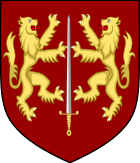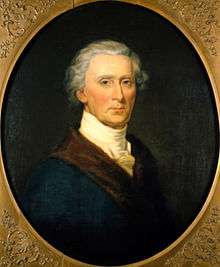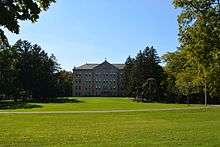Carroll Hall (University of Notre Dame)
Carroll Hall is one of the 31 Residence Halls at the University of Notre Dame. It located on the shores of St. Mary's Lake. Built in 1906 and a residence hall since 1966, Carroll is the smallest of the residence halls, housing around 100 undergraduates. Its mascot is the Vermin, and its colors are crimson and gold. The coat of arms is based on the Carroll family, adapted to the dorm colors. The hall is named after Charles Carroll, Founding Father and the only Catholic signer of the Declaration of Independence.[2]
| Carroll Hall | |
|---|---|
 | |
| Campus quad | South |
| Motto | All are most welcome. |
| Established | 1906 |
| Named for | Charles Carroll of Carrollton |
| Architect | Br. Charles Borromeo Harding |
| Colors | Crimson and gold |
| Gender | Male |
| Rector | Eric T. Styles |
| Undergraduates | 102 |
| Postgraduates | 2 (serving as Assistant Rectors) |
| Chapel | St. André Bessette |
| Mascot | Vermin |
| Interhall sports | Baseball, basketball, bowling, cross country, dodgeball, football, golf, hockey, lacrosse, racquetball, soccer, table tennis, tennis, volleyball |
| Charities | Boys & Girls Clubs of St. Joseph County |
| Major events | A Carroll Christmas, Lakeside Music Festival (w/ Badin), Volley For Vets (w/ Lyons), Carroll Masters |
Carroll Hall | |
 | |
| Location | Notre Dame, Indiana |
| Coordinates | 41°42′08″N 86°14′52″W |
| Built | 1906 [1] |
| Architect | Br. Charles Borromeo Harding, CSC [1] |
| Architectural style | Collegiate Gothic |
| Part of | University of Notre Dame: Main and South Quadrangles (ID78000053) |
| Added to NRHP | May 23, 1978 |
| Website | http://carrollhall.nd.edu |
History

Carroll Hall was constructed in 1906 by Brother Charles Borromeo Harding and christened "Dujarie Institute" after Jacques-François Dujarié.[3] Dujarié had founded in 1820 the Brothers of St. Joseph, who eventually on August 31, 1835 came under the control of Basil Moreau, CSC, and they developed into the Brothers of the Congregation of Holy Cross.[4] From then, it was used as a seminary for the Brothers of Holy Cross, the Dujare institute or scholasticate, where the novitiates studies and lived before professing their final vows. In 1920, Blessed Brother André Bessette lodged in the building, in room 306, a small plain chamber with white walls and a single window, which today has been incorporated in the suite occupied by the assistant rector.[5] In 1966, the Brothers sold the property to the University of Notre Dame, and in the fall of 1966 around a 100 students moved in.[6] Rev. Thomas McDonagh CSC was its first rector.[7]
In 1966, the building's name was changed to Carroll Hall, in honor of Charles Carroll.[8][9] He is sometimes referred to as one of the Founding Fathers of the United States of America, although he was not involved in framing the United States Constitution. He served as a delegate to the Continental Congress and Confederation Congress and later as first United States Senator for Maryland. He was the sole Catholic signer of the Declaration of Independence.[10] Carroll was the last surviving signer of the Declaration of Independence, and the longest lived.[11] He was also the cousin of the first Catholic Bishop in the United States, Archbishop John Carroll, of which the University holds several memorabilia in the museum of the Basilica of the Sacred Heart.[12][13] The Carroll family has had a huge impact in the history of Catholicism in the United States and Notre Dame.[14] The name Carroll Hall had originally been given to a dormitory for approximately 350 boys 13–17 years old that was located in the west wing of the Main Administration building, but it was suppressed in 1946 when the rooms were converted into office space and the name retired.[15]
Since 1966, Carroll has housed undergraduate male students, except briefly from 1970 until 1977, when it hosted graduate students. Ever since Holy Cross Hall was demolished in 1990, Carroll has been the only undergraduate dormitory on a lake. The current rector is Eric T. Styles, from Chicago, who received a BFA in Electronic Media from the University of Cincinnati College-Conservatory of Music and an MA in Applied Philosophy from Loyola University Chicago. he previously worked at The Theatre School at DePaul University and in Campus Ministry at Saint Mary's University of Minnesota in Winona.[16]
Description
Carroll Hall lays on the southwest shores of St. Mary's Lake, from which it enjoys views of the Main Administration Building and the Basilica of the Sacred Heart.[17] In front of the building is Carroll Lawn, also known as Far Quad, and hosts a sand volleyball court, and i between the hall and the lake is a basketball court.[18]
The hall is a five-story building in yellow Notre Dame brick, with classical decorations and a simple unadorned facade. Its architect was Br. Charles Borromeo Harding, who also worked on Crowley, St. Edward's, and Corby Halls, and also on the Basilica. The first floor host mainly social spaces, with a large living room with portraits of past presidents, a kitchen, study rooms, the mailroom, and the chapel. The chapel is modern and simple, and is dedicated to St. André Bessette. The basement hosts a laundry room, a fitness room, and storage and utility spaces. The upper floors hosts the dorm rooms, which are mostly singles, doubles, triples and quads.[19]
Traditions
Nicknamed the Vermin, Carroll Hall is known for its distance from the rest of campus, and is nicknamed 'Siberia' in the winter. It has the smallest populations of students and the largest rooms on campus.[20] The distant location from the rest of the campus and the small size of the dorm, makes the community especially tight knit and has given rise to many traditions and unique features.[21]

Each year, before the first home football game, the approximately 35 First Years in Carroll dye their hair blond, in a tradition dubbed Vermin Go Gold, in support of the football team.[21] On football Saturdays, the Hall's facade is draped with a huge banner displaying the text "GO IRISH".[22][23] It is made out of 72 bed sheets, 52,000 staples, and 5 gallons of green paint, and it is raised up on Friday afternoons.[24]
Started in 1998 and held on the first Friday of December, Carroll Christmas is one of Notre Dame's best known signature events and is Carroll's signature event.[25][26] Events feature the lighting a 40-foot Christmas tree, performances from on-campus groups like the Glee Club and Humor Artists, Christmas carols from all the Vermin, horse-drawn carriages on Carroll Drive, dance parties, a giant "C" hanging on the facade, and paper luminaries.[27][28] Carroll residents also dress up as Santa Claus, Mrs. Claus, and the elves to entertain the guests, which comprise around a 1000 students every year.[29] In recent years, Carroll Christmas has featured an appearance by ESPN College Gameday Analyst Digger Phelps, an extremely competitive cookie contest, and a horse-drawn carriage from LaFortune student center all the way to Carroll. Previously, into the mid-1990s, Carroll Hall held an annual haunted house on the Friday closest to Halloween.
Since 2015 (as part of AnToastal), Carroll has launched the Lakeside Music Festival, which takes place in the spring and it includes music by many different campus groups, food, sports, and other activities, and it raises money for the Boys & Girls Club of St. Joseph's County.[30] Other events include Third Floor Abs, a fitness program that has spread throughout campus, and Friday cookouts, which take place on the FarQuad in front of the lake. Carroll Hall's charity efforts go towards helping Boys & Girls Club of St. Joseph's County, and Carroll residents volunteer to help kids with homework and provide school supplies.[31]
Notable residents
- Carlyle Holiday
- Jeff Burris[32]
- Bertrand Berry
- Miles Boykin
- Jimmy Brogan [33]
- Greg Andres
- Sean Conley
- Arnaz Battle
- Anthony Weaver
- Peter Richardson (American director)
References
- "Official Building Inventory" (PDF). Facilities Design and Operations. University of Notre Dame. 1 October 2015. Archived from the original (PDF) on 4 March 2016. Retrieved 11 November 2015.
- "Charles Carroll". Retrieved 30 January 2019.
- "Hall Portrait: Carroll // News // Notre Dame Magazine // University of Notre Dame". magazine.nd.edu. Retrieved 31 January 2019.
- O'Neill, Arthur Barry. "Congregation of the Holy Cross". Catholic Encyclopedia (1913). 7. Retrieved 31 January 2019.
- Fosmoe, Margaret. "Future saint paid ND a visit in 1920". South Bend Tribune. Retrieved 7 December 2018.
- "Which Came First" (PDF). Alumnus. 44 (4): 8. July–August 1966. Retrieved 31 January 2019.
- "Appoint New Hall Rectors" (PDF). 44 (5). September–October 1966. Retrieved 31 January 2019. Cite journal requires
|journal=(help) - DSDI staff (30 November 2011). "Charles Carroll of Carrollton". The Society of the Descendants of the Signers of the Declaration of Independence. Retrieved 30 January 2019.
- Spignesi, Stephen (2016). 499 Facts about Hip-Hop Hamilton and the Rest of America's Founding Fathers: 499 Facts About Hop-Hop Hamilton and America?'s First Leaders. Simon and Schuster. ISBN 9781510712133.
- "Charles Carroll, of Carrollton," The American Catholic Quarterly Review, Vol. XXIV, 1899.
- "Charles Carroll of Carrollton – The Signer". Charles Carroll House. 17 March 2011. Retrieved 31 January 2019.
- "Bishop's collection". Retrieved 31 January 2019.
- Hagerty, James Edward. "Charles Carroll of Carrollton". Catholic Encyclopedia (1913). Retrieved 31 January 2019.
- Carroll Carter, Charles (March 2001). "Catholic Founding Fathers The Carroll Family". Crisis. 19 (3): 32–33.
- "Which Came First" (PDF). Alumnus. 44 (4): 8. July–August 1966. Retrieved 31 January 2019.
- "Carroll Hall // Residential Life // University of Notre Dame". Residential Life. Retrieved 31 January 2019.
- "Caroll Hall". Residential Life. Retrieved 31 January 2019.
- "Setting – Carroll Hall". carrollhall.nd.edu. Retrieved 31 January 2019.
- "Building Information – Carroll Hall". carrollhall.nd.edu. Retrieved 31 January 2019.
- "Irish Legends". IrishIllustrated.com.
- Owens, Andrew (4 November 2010). "Proud to be Vermin // The Observer". The Observer. Retrieved 30 January 2019.
- "Carroll Hall raises GO IRISH! banner". Retrieved 30 January 2019.
- Domer, The Daily (1 July 2018). "Built in 1906 and converted into a men's residence hall in 1967, Carroll Hall is seen here, from the air, hanging its signature "GO IRISH" banner on a football weekend. @CarrollHall #photooftheday #dormaday(Photo by Matt Cashore/Copyright University of Notre Dame)pic.twitter.com/oB8IAldSPA". @DailyDomer. Retrieved 30 January 2019.
- "University of Notre Dame 2017-18 Dorm Overview". Issuu: 6. Retrieved 30 January 2019.
- Dalum, Kevin (December 7, 1998). "Carroll Hall Christmas" (PDF). The Observer. XXXII (63): 6. Retrieved 31 January 2019.
- "Traditions – Carroll Hall". carrollhall.nd.edu.
- "Best Campus Holiday Traditions". League91.com. 12 December 2017. Retrieved 30 January 2019.
- "University of Notre Dame 2017-18 Dorm Overview". Issuu. Retrieved 30 January 2019.
- "Carroll Hall rings in Carroll Christmas // The Observer". The Observer. 1 December 2016. Retrieved 30 January 2019.
- Ramos, Adam (16 April 2015). "Kick off Antostal at Lakeside // The Observer". The Observer. Retrieved 31 January 2019.
- "University of Notre Dame 2017-18 Dorm Overview". Issuu. Retrieved 31 January 2019.
- ncblisa (July 11, 2012). "Where Are They Now? Jeff Burris". No Coast Bias. Retrieved February 23, 2017.
- "Directory 1967-1968" (PDF). Retrieved 31 January 2019.
